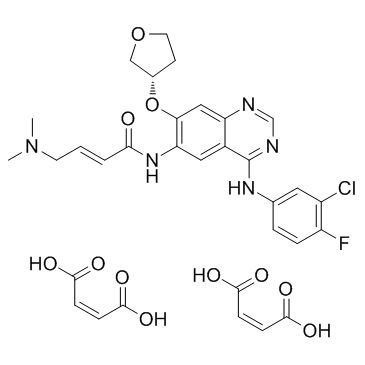850140-73-7
| Name | afatinib dimaleate |
|---|---|
| Synonyms |
2-Butenamide, N-[4-[(3-chloro-4-fluorophenyl)amino]-7-[[(3S)-tetrahydro-3-furanyl]oxy]-6-quinazolinyl]-4-(dimethylamino)-, (2E)-, (2Z)-2-butenedioate (1:2)
(2E)-N-(4-[(3-chloro-4-fluorophenyl)amino]-7-{[(3S)-tetrahydrofuran-3-yl]oxy}quinazolin- 6-yl)-4-(dimethylamino)but-2-enamide bis[hydrogen (2Z)-but-2-enedioate] Afatinib maleate (JAN) Gilotrif (TN) Afatinib dimaleate (USAN) 2-Butenamide, N-[4-[(3-chloro-4-fluorophenyl)amino]-7-[[(3S)-tetrahydro-3-furanyl]oxy]- 6-quinazolinyl]-4-(dimethylamino)-, (2E)-, (2Z)-2-butenedioate (1:2) (Z)-but-2-enedioic acid,(E)-N-[4-(3-chloro-4-fluoroanilino)-7-[(3S)-oxolan-3-yl]oxyquinazolin-6-yl]-4-(dimethylamino)but-2-enamide BIBW 2992MA2 Afatinib dimaleate (2E)-N-{4-[(3-Chloro-4-fluorophenyl)amino]-7-[(3S)-tetrahydro-3-furanyloxy]-6-quinazolinyl}-4-(dimethylamino)-2-butenamide (2Z)-2-butenedioate (1:2) Afatinib maleate Gilotrif BIBW2992 DiMaleate Afatinib (dimaleate) |
| Description | Afatinib dimaleate is an irreversible EGFR family inhibitor with IC50s of 0.5 nM, 0.4 nM, 10 nM and 14 nM for EGFRwt, EGFRL858R, EGFRL858R/T790M and HER2, respectively. |
|---|---|
| Related Catalog | |
| Target |
EGFR:0.5 nM (IC50) HER2:14 nM (IC50) EGFRL858R:0.4 nM (IC50) EGFRL858R/T790M:10 nM (IC50) |
| In Vitro | In cell-free in vitro kinase assays, Afatinib (BIBW2992) dimaleate shows potent activity against wild-type and mutant forms of EGFR and HER2, similar to Gefitinib in potency for L858R EGFR, but about 100-fold more active against the Gefitinib-resistant L858R-T790M EGFR double mutant, with an IC50 of 10 nM. BIBW2992 is furthermore comparable to Lapatinib and Canertinib for in vitro potency against HER2, with an IC50 of 14 nM. The most sensitive kinase in this evaluation is lyn with an IC50 of 736 nM[1]. Afatinib is an irreversible inhibitor of these ErbB family receptors. Esophageal squamous cell carcinoma (ESCC) cell lines are sensitive to Afatinib with IC50 concentrations at lower micro-molar range (at 48 hour incubation: HKESC-1=78 nM, HKESC-2=115 nM, KYSE510=3.182 μM, SLMT-1=4.625 μM and EC-1=1.489 μM; and at 72 hour incubation: HKESC-1=2 nM, HKESC-2=2 nM, KYSE510=1.090 μM, SLMT-1=1.161 μM and EC-1=109 nM) with a maximum growth inhibition over 95%. Afatinib can strongly induce G0/G1 cell cycle arrest in HKESC-2 and EC-1 in a dose- and time-dependent manner[2]. |
| In Vivo | Afatinib (15 mg/kg) strongly inhibits the growth of HKESC-2 tumor once the treatment began. Average tumor sizes of vehicle and treatment at end point are 348±24 mm3 and 108±36 mm3 respectively, showing significantly difference between them. And apparently tumor size does not bounce back in a short period of time after the end of Afatinib administration. Without rapid change of body weight throughout the treatment shows that the toxicity of Afatinib is minimal and this drug is well tolerated[2]. |
| Kinase Assay | The EGFR kinase domain-GST fusion proteins are extracted from Sf9 biomasses, 72 hours post infection, with HEPEX (20 mM HEPES pH 7.4, 100 mM NaCl, 10 mM β-glycerophosphate, 10 mM para-nitro-phenylphosphate, 30 mM NaF, 5 mM EDTA, 5% glycerol, 1% Triton X-100, 1 mM Na3VO4, 0.1% SDS, 0.5 µg/mL pepstatin A, aprotinin 20 KIU/mL, Leupeptin 2 µg/mL, Benzamidine 1 mM, 2.5 μg/mL 3,4-dichloroisocoumarin, 2.5 μg/mL trans-epoxysuccinyl-L-leucyl-L-amido butane and 0.002% PMSF) and used for the determination of the IC50 values. Each 100 µL enzyme reaction contains 10 μL of Afatinib (BIBW2992) in 50 % Me2SO, 20 μL of substrate solution (200 mM HEPES pH 7.4, 50 mM Mg-acetate, 2.5 mg/mL poly (EY), 5 μg/mL bio-pEY) and 20 µL enzyme preparation. The enzymatic reaction is started by addition of 50 µL of a 100 µM ATP solution made in 10 mM MgCl2. Assays are carried out at room temperature for 30 minutes and terminated by the addition of 50 µL of stop solution (250 mM EDTA in 20 mM HEPES pH 7.4). 100 µL are transferred to a streptavidin coated microtiterplate, after an incubation time of 60 min at room temperature the plate is washed with 200 µL of wash solution (50 mM Tris, 0.05% Tween20). A 100 µL aliquot of a HRPO- labeled anti-PY antibody (PY20H Anti-Ptyr:HRP supplied by Transduction Laboratories) 250 ng/mL are added to the wells. After 60 min of incubation, the plate is washed three times with a 200 µL wash solution. The samples are then developed with a 100 µL TMB Peroxidase Solution (A:B=1:1). The reaction is stopped after 10 min. The plate is transferred to an ELISA reader and extinction is measured at OD450nm. All data points are performed in triplicates[1]. |
| Cell Assay | Human ESCC cell lines, EC-1, HKESC1 and HKESC2, SLMT1, and KYSE510 are cultured in RPMI with 10% fetal bovine serum (FBS). Cytotoxicity is assessed by a colorimetric assay using MTT. Tumour cells are cultured in 48-well plates (3000-8000 cells per well) in respective culture medium. Afatinib in complete medium is added at 24 hr after cell plating and incubated at 37°C with 5% CO2 for 48 and 72 hr. Cell growth inhibition is expressed as the percentage of absorbance of control cultures measured at 570 nm with a microplate reader and 50% of the maximum growth inhibition (IC50) is calculated by GraphPad PRISM. In each experiment, triplicate wells are performed for each drug concentration (n=3), and assay is repeated in three independent experiments[2]. |
| Animal Admin | Mice[2] Six weeks old female athymic nude mice (nu/nu) weighing about 16-20 gram are used. ESCC xenografts are established by inoculating HKESC-2 (6×104 cells re-suspended in 50 μL of HBSS-buffer) subcutaneously into both flanks of the nude mice. When tumor size reached to 4-6 mm diameter, they are randomized in either treatment (15 mg/kg) or vehicle control group. Afatinib for treatment is prepared by dissolving in 0.5% methylcellulose before administration. Either drug or vehicle is administered to mouse by oral gavage in a schedule of 5 days on plus 2 days off for two weeks. Drug efficacy is evaluated by monitoring the change in tumor size with caliper. Tumor volume is calculated with the formula Tumor Volume=(width2×length)/2. |
| References |
| Molecular Formula | C32H33ClFN5O11 |
|---|---|
| Molecular Weight | 718.083 |
| Exact Mass | 717.184937 |
| PSA | 241.30000 |
| LogP | 4.53600 |
| Hazard Codes | Xi |
|---|---|
| HS Code | 29339900 |

